
Tom and Rita at work in the studio
The setting is unpropitious: a range of farm buildings in Dargate, utilitarian and without architectural pretension. Now redundant, they have been converted to business units where a range of enterprises, including technology companies, an artisan cheesemaker, a marine carpenter and, not least, Arte Conservation, ply their highly skilled crafts and callings.
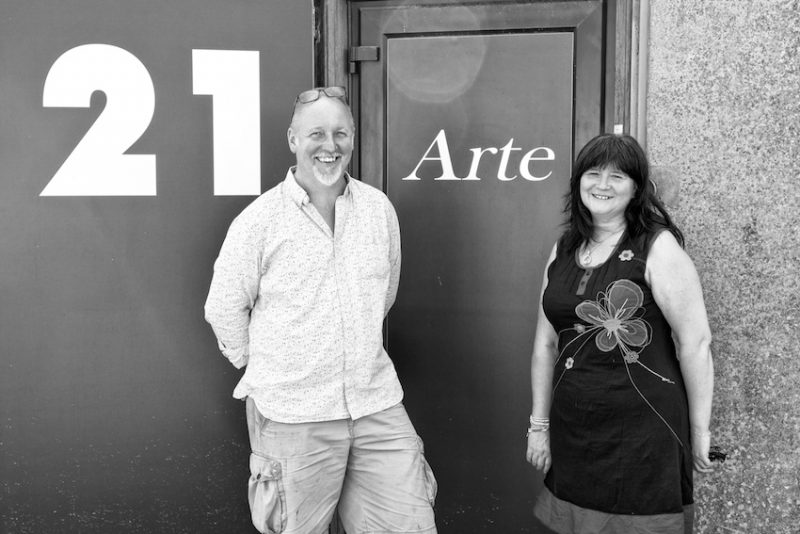
Tom and Rita – the entrance to the studio
The modest entrance to Unit 21 opens to reveal an extraordinary interior, originally a single space, now with an upper as well as a ground floor. ‘It was just an empty space when we moved in’, says Tom. ‘As it warmed up, it was like a rain forest and everything started to thaw.’ The solution was installing insulating bubble wrap, which enhances the light filling this unexpected interior. It is now a mixture of state-of-the-art-equipment and specialised lighting, combined with improvised partitioning made from corrugated clear PVC. There is a wood-burning stove, a well-stocked kitchen in an open-plan corner, an inviting sofa, Rita’s desk and shelves of reference books.

Before and after treatment: Ferdinand Platner’s painting of Our Lady with the Holy Child and the Figures of St Augustine and St Thomas of Canterbury, now returned to AWN Pugin’s Church of St Augustine at Ramsgate
Dominating everything, however, are the magnificent paintings that Tom and Rita are currently working on, applying the meticulous and challenging analyses and treatments involved in the conservation of fragile works of art.
Tom, who has particular expertise in the conservation of wall paintings, has won many awards, among them the Europa Nostra, the EU Prize for Cultural Heritage, for his work on the hand-painted wallpaper in the entrance hall and above the staircase at Walpole’s ‘little gothic castle’ at Strawberry Hill.

Tools of conservation practice

Plain white glazed tiles are used as palettes for mixing specialist retouching colours with reversible conservation media or varnish
Tom got involved by chance in 1981 when he was 19. He was looking for interesting work, and found it in the department at Canterbury Cathedral that just happened to do wall painting restoration. ‘I began by slaking lime and mixing up mortars – the structural side of conservation work. They set up an apprenticeship and I stayed.’ He was there for ten years, in his final year taking over as director of the workshop.
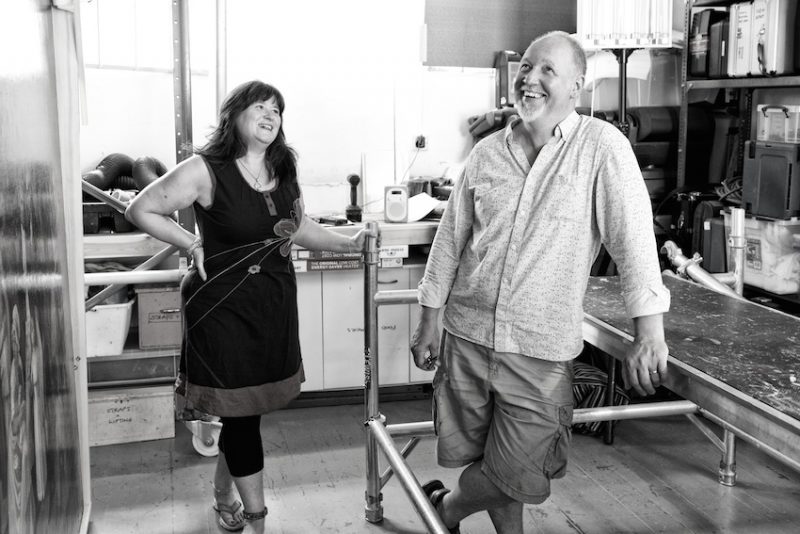
Rita and Tom downstairs in the studio
Tom had been gradually taking on outside work; when he left he had nine months’ work lined up. For the next 23 years he worked with independent conservators who had formed The Wall Paintings Workshop, carrying out a wide range of work around the world. This included leading the team of archaeologists and conservators brought together to conserve the 6th, 10th and 14th century mosaics in the dome of the Museum of the Hagia Sofia in Istanbul. ‘In an area 10cm square, there would be 120 pieces of gold and glass,’ explains Tom. New pieces were prepared by layering glass and gold leaf, firing it again and cutting it up. At least 45 million pieces were made. ‘The thrill of it is that everything we do is different. We have to think about what the client wants as well as what will be the best result for the money available.’
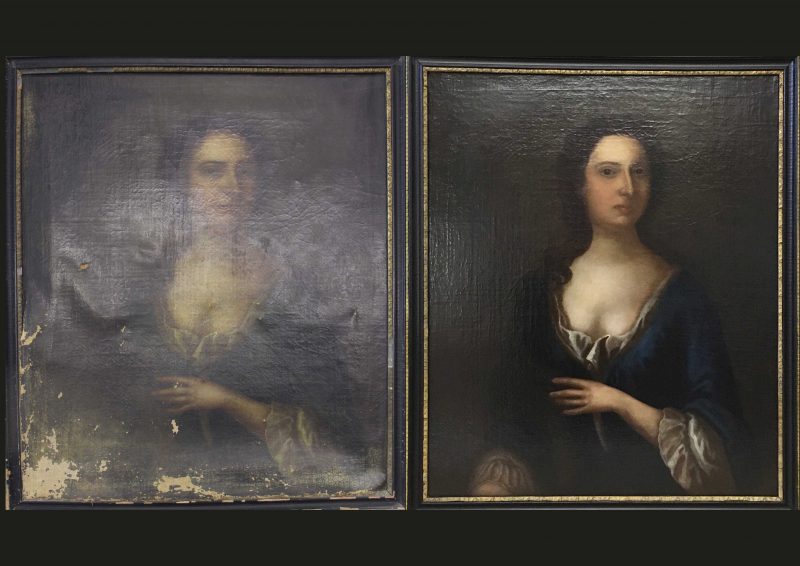
Before and after: a damaged family portrait restored by Rita to its 18th century glory
Rita, who shares the studio, has been working with Tom on projects for 25 years. She trained at the City & Guilds of London Art School in Kennington, studying conservation and restoration in wood and stone polychrome sculpture. After college, she restored paintings and frames for art dealers in London and worked as a freelance for other restorers on large conservation projects such as Chatsworth House in Derbyshire and Norwich Castle Museum. Rita moved to Faversham 12 years ago. She works mainly on easel paintings for private owners, and helps Tom out on large projects in the studio and on site – churches and stately homes and wall paintings dating from medieval to modern times. Arte Conservation Ltd’s clients include English Heritage (now renamed Historic England), the National Trust, cathedrals, churches, museums and historic buildings in private and public ownership.
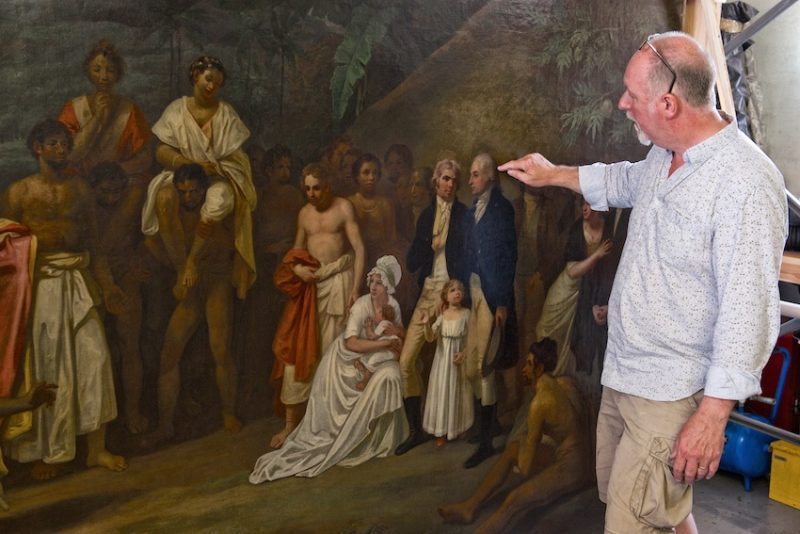
Recently acquired by the National Maritime Museum, Robert Smirke’s striking painting of The Cessation of the District of Matavai in the Island of Otaheite (Tahiti) to Captain james Wilson (1798)
Much of the ground floor of the studio is currently taken up by a striking 10ft x 7ft painting by Robert Smirke, recently acquired by the National Maritime Museum. Titled The Cessation of the District of Matavai in the Island of Otaheite (Tahiti) to Captain James Wilson (1798), the painting depicts the transfer of land from tribal elders to Captain James Wilson (it is doubtful given the celebratory nature of the event that there is a shared understanding of ownership). The tribal elders are heavily tattooed and the couple being carried have elevated status, as do those wearing red robes. The painting has been restored and retouched in the past and there are areas of discolouration. Powder pigments specially made for restorers will be used in the current work. The project was intended to take a year, but will take longer. When cleaned and restored, the painting will go on display in the Museum’s new Pacific gallery scheduled for opening in the summer of 2018.

Queen Anne’s coat of arms on the hot table
Also being worked on is a magnificent coat of arms for Queen Anne. It has a wooden backing and will be patiently and skilfully relined using the hot table upstairs. The process involves new canvas, heat-seal adhesive, multiple layers of Melinex polyester film and a vacuum system. Painted boards such as hatchments are regularly restored by the Arte Conservation team. Carried in front of funeral processions, displayed outside their house and later hung in the church, hatchments bear the arms, crest or motto of the person who has died.
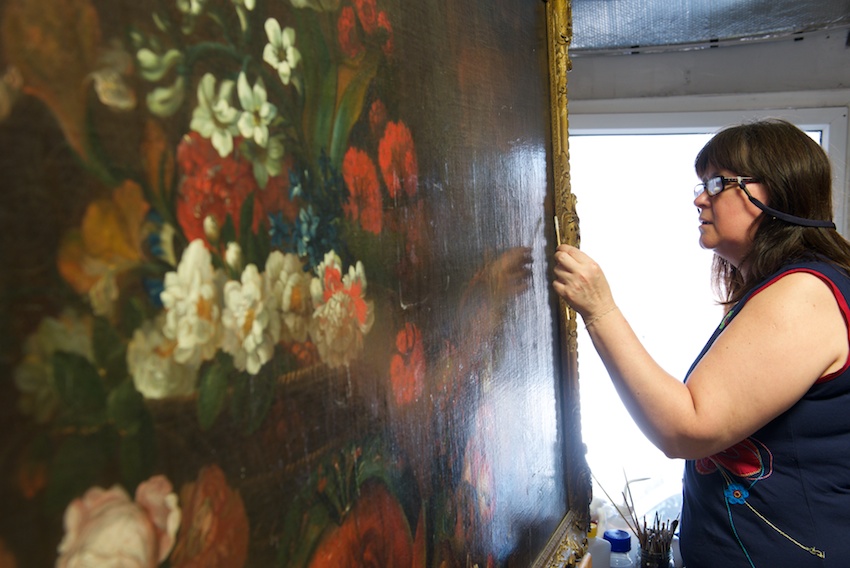
Rita, who shares the studio, has been working with Tom on projects for 25 years
Another current project is a still life by Jacob Bogdani. This depicts flowers and fruit and a squirrel and is from Maidstone Museum. Tom and Rita strap on some serious magnifying glasses to study the condition of paint and varnish. Ultraviolet light is used to pick up different varnishes and old retouching. Studio lamps have daylight bulbs for colour accuracy. A cool, clear light is required for retouching.

Ultraviolet light is used for forensic work on different varnishes and old retouching
Theirs is a highly skilled, meticulous and patient vocation, time-consuming and slow. Even a modest family portrait may take a year as it competes for attention within a demanding workload. Sometimes, recalls Rita, there can be challenges from clients. A dealer once asked her to ‘put a smile on the face of a dog that was growling, as he couldn’t sell it.’ Rita naturally refused: ‘It can be done – you can move trees around, redo the sky if it’s gloomy, or make a pig into a horse’. At Arte Conservation, professional and artistic integrity are not compromised.
www.arteconservation.com/single-post/2017/05/19/Return-to-Ramsgate
Text: Sarah. Photography: Lisa